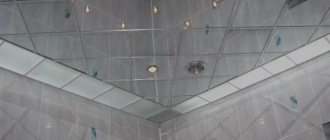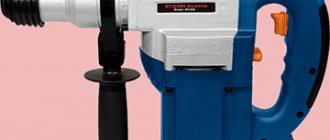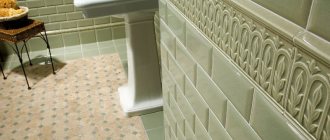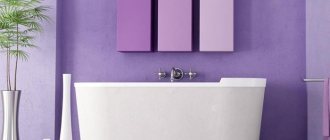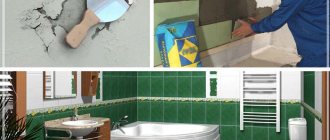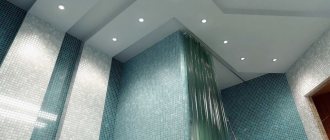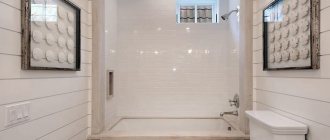For more than several decades, we have become accustomed to using exclusively ceramic tiles to decorate the bathroom, believing that this material is capable of reliably and efficiently protecting the room from moisture.
However, today there is a newer and more original alternative to tiles - Venetian plaster. The material is attractive, reliable and water-repellent.
It is safely used for finishing bathrooms and even swimming pools. The advantage of the material lies in its composition, which contains a special layer of protection for the walls from moisture penetration.
Venetian plaster in the bathroom
The plaster itself is presented in the form of a putty mass, mainly consisting of marbled dust, which is sometimes replaced with quartz, granite or onyx. The second component of the composition is slaked lime. It ensures the strength of the finish, which means it increases its service life. In order for the plaster to acquire a particular color, an appropriate pigment is added to the material, which not only decorates, but also protects the walls from ultraviolet rays and air.
Today, a new type of Venetian plaster is presented on the market, which includes liquid acrylic. Some experts believe that such material is more elastic and not susceptible to cracking. However, remember that such a composition is less environmentally friendly than classic water-based plaster.
Can it be used in the bathroom?
Due to the high air humidity, finishing materials for the bathroom are chosen especially carefully. Thanks to moisture-resistant plastered surfaces, it is possible to create not only a comfortable, beautiful and presentable design, but also quite safe and practical.
Features of bathroom design
The nuances of decorating this room:
- When choosing, it is necessary to take into account the composition, moisture-resistant and strength qualities of the decorative finishing material.
- Gypsum-based plaster is best suited for a well-ventilated bathroom, a relatively dry bathroom or a spacious shower room.
- The plaster mixture is selected taking into account the material from which the wall or ceiling is made.
- In a small bathroom, it is not advisable to use decorative finishes in too dark shades.
The photo shows decorative metallic plaster with a silver effect in the bathroom.
Features of the composition
Depending on the composition, the plaster is:
- Polymer. The mixture protects against cracks, since after drying it creates a thin flexible film that has improved adhesion to the base. The plaster fits perfectly on drywall, primed metal, MDF, and concrete. The surface is resistant to temperature changes.
- Limestone. In terms of moisture resistance, it is slightly worse than the polymer type, but has better vapor permeability. The material is resistant to mold and mildew, as well as frost.
If the composition contains lime and cement, then it is called mineral. And in the presence of quartz chips, the material is called silicate plaster. The binding component is acrylic or silicone. Acrylic compositions are more affordable and suitable for independent work.
Pros and cons of finishing
Advantages and disadvantages of decorative plaster.
| pros | Minuses |
| This decorative finish is moisture-resistant, fire-resistant, environmentally friendly, non-toxic and has good antistatic properties. | It has a rather complex application that cannot be handled without the help of professionals. |
| It has high vapor permeability, which allows you to create a favorable microclimate in the room and does not imply the development of fungus. | |
| The material is well washable and fairly easy to care for. | It is also difficult to dismantle. |
| Due to the huge number of colors, shades, the ability to imitate various materials and create a relief patterned surface, this decorative finish allows you to create a unique design. |
Preparing the walls
Surface preparation before plastering
A special feature of using moisture-resistant decorative plaster indoors is the preparation of walls. The basic ability to resist moisture depends on the materials used to level the walls and form the base for the decor. Special moisture-repellent cement-based mixtures or gypsum plasters, such as Rotband, are well suited for this.
Today there are also more modern materials, for example, sanitizing plaster for the bathroom. This is a type of cement-sand mixture to which certain components have been added, thanks to which it has a number of advantages over other plaster options:
- Creation of a moisture-proofing layer;
- The ability to regulate the microclimate of the room, absorbing and releasing moisture;
- Resistance to salt precipitation, which destroys most building materials, especially in humid environments;
- Crack resistance;
- Environmental Safety.
What can be finished with decorative plaster?
Design options for various surfaces:
- Walls. With the help of such a decorative coating with special additives, it is possible to create relief and accent walls in the bathroom and embody real interior masterpieces.
- Ceiling. A plastered ceiling plane significantly improves the aesthetic and decorative qualities of a room, making it stylish and unique in its own way.
Decorative plaster for walls or ceilings is an ideal material for creativity, allowing you to create both smooth and textured surfaces.
The photo shows a small bathroom with walls decorated with beige plaster.
List of tools and materials
To make high-quality renovations in the bathroom using decorative plaster, you will need to have a whole list of tools and materials available. It includes a putty knife, trowel, builder's or water level, putty, primer, sanitizing plaster, brush, brush, wax or paint. You will need to purchase a sufficient amount of decorative mixture. Thus, decorative plaster is a modern facing material that is suitable for any room in a house or apartment. Absolutely anyone can make such repairs with their own hands; you just need to know the basic stages of the work and certain skills. Proper preparation of the base is of great importance.
Types of decorative plaster
There are several varieties.
Venetian
Venetian can be an imitation of granite, marble, travertine or other stone textures. It is applied in layers and quite often covered with wax, which allows creating not only additional protection from water, but also, due to the resulting glossy texture and smooth tints, giving the surface a special sophistication and luxury.
Textured
Thanks to a well-chosen composition of components, textured finishes are used to create bas-reliefs or panels and perfectly imitate leather, brick, sand, stone, velvet or other surfaces.
Structural
Due to the mineral and wood granulate in the composition, the structural coating allows you to create various patterns or roughness on the surface. The most famous techniques for applying this composition are bark beetle, lamb or fur coat.
The photo shows decorative structural plaster in the interior of a modern bathroom.
Story
This method of finishing has existed for a couple of thousand years and arose earlier than its current name. Even the builders of Ancient Rome noticed that waste stones in the form of dust and fragments can be used to create a finishing mixture, which, thanks to a special application technique, will be no worse than marble.
The plaster recipe became in demand in Venice during the Renaissance, which is where the name came from. Nowadays such finishing is used to decorate not only the interior space, but also the exterior. Moisture-resistant Venetian plaster for the bathroom, if properly finished, can last for many years. A room decorated with this material always looks luxurious.
According to reviews, Venetian plaster in the bathroom looks great, not only if it is purchased. You can do it yourself. To do this, you need stone chips, which may be available in a workshop where they work with marble and granite. Slaked lime is sold in construction stores, and colors are sold in places where paints and plasters are sold. Factory-made formulations have a consistent recipe and certain properties, unlike home-made mixtures.
Bath interior color scheme
Decorative plaster has a huge variety of color schemes, with the help of which it is possible to create a certain mood in the bathroom or toilet and bring new emotions and impressions into the environment.
- White.
- Grey.
- Black.
- Beige.
- Gold.
- Green.
- Red.
- Blue.
When choosing a shade, first of all you should take into account the style of the room and all the nuances of the interior. Thanks to certain colors, tinted plaster will help create a bright accent that will become a very interesting design feature of the room, refresh the space or give the environment a more stylish, fashionable or sophisticated and rich look.
The photo shows the interior of a bathroom with walls decorated with light beige plaster.
Room design options
Due to the wide possibilities of this decorative finish, it is possible to achieve a flawless and aesthetic surface, which will not only serve to create an exclusive environment, but will also retain its appearance for many years.
- Marbled.
- Under concrete.
- Silk.
- Colored.
- Combination with tiles.
The photo shows decorative black marble plaster in the bathroom.
Plaster is an alternative to expensive analogues, for example, gems or other natural minerals. Finishing with such a texture will give the bathroom a unique unique character.
The photo shows the interior of a classic bathroom with plaster combined with tiles.
What style is best to decorate a bathroom?
The choice of decorative finishing material occurs in accordance with the specified style. This cladding allows you to embody a wide variety of design ideas and experiments and transform an ordinary, smooth, seamless coating into a spectacular and sophisticated design.
- Minimalism.
- Classic.
- High tech.
- Loft.
The photo shows glossy peach-colored plaster on the walls in a classic-style bathroom.

